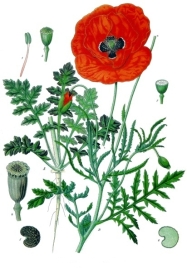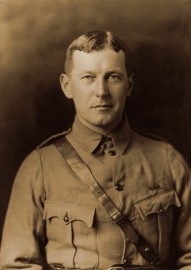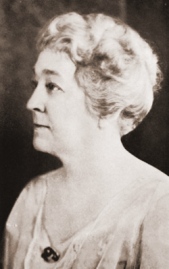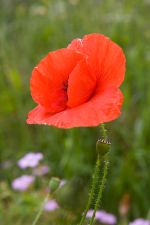
Red poppies have long been a symbol of eternal sleep, resurrection and love: In ancient mythologies of Greece and Rome, poppies were given as offerings to the dead; in Urdu they are sometimes a symbol of martyrdom; and in classic Persian literature, the red poppy is a flower of love and often represents those who died for love. Well into the 20th Century, poppies were used as emblems on tombstones. And since World War I, Papaver rhoeas, or the red-flowered corn poppy, has been the flower of remembrance for fallen soldiers.
The flower’s opiate qualities help explain its relationship to “eternal sleep,” and the red color its role as a symbol of death. But Papaver rhoeas is also a highly successful plant — quickly self-seeding, adaptable, happy in disturbed soil, bad-tasting to grazing animals, and a scourge of agriculture for centuries.
In other words: A weed. But why would a weed come to honor fallen soldiers?

John McCrae
In Flanders fields the poppies blow
Between the crosses, row on row…
The poppies that McCrae saw growing wild in the battlefields were Papaver rhoeas. The disturbed ground caused by trench warfare had proved irresistible to the red-flowered corn poppy.
Published in 1915, In Flanders Fields became one of the most popular poems of war — inspiring American professor Moina Michael to compose a poem in reply, We Shall Keep the Faith:

Moina Michael
That grows on fields where valor led;
It seems to signal to the skies
That blood of heroes never dies…
Michael also began the tradition of wearing a red poppy on Memorial Day in the U.S., and made and sold red poppies made of silk (called “Buddy Poppies”) to raise funds to aid disabled veterans and their families. In 1922, Veterans of Foreign Wars adopted Michael’s program and became the first veterans organization to nationally sell Buddy Poppies.
In Flanders Fields has since become one of the most frequently quoted English-language poems of the first World War, translated into numerous languages over the years; McCrae himself is an iconic personage in Canada, his birthplace now a historical museum. Moina Michael helped launch a memorial poppy program in France, and was honored with a commemorative stamp in 1948 for her humanitarian work.
And today in the U.S., Buddy Poppies are made by veterans, providing financial and therapeutic benefit to thousands of disabled vets and their families.

Full text of In Flanders Fields
Full Text of We Shall Keep the Faith
Poppy info: here, here, and here.
For more on the work of Veterans of Foreign Wars, visit VFW.org.
All images from Wikimedia Commons.